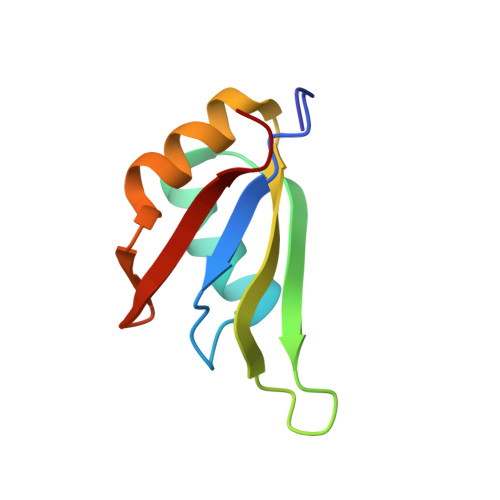Structural and dynamic studies of the human RNA binding protein RBM3 reveals the molecular basis of its oligomerization and RNA recognition.
Roy, S., Boral, S., Maiti, S., Kushwaha, T., Basak, A.J., Lee, W., Basak, A., Gholap, S.L., Inampudi, K.K., De, S.(2022) FEBS J 289: 2847-2864
- PubMed: 34837346
- DOI: https://doi.org/10.1111/febs.16301
- Primary Citation of Related Structures:
7EB1 - PubMed Abstract:
Human RNA-binding motif 3 protein (RBM3) is a cold-shock protein which functions in various aspects of global protein synthesis, cell proliferation and apoptosis by interacting with the components of basal translational machinery. RBM3 plays important roles in tumour progression and cancer metastasis, and also has been shown to be involved in neuroprotection and endoplasmic reticulum stress response. Here, we have solved the solution NMR structure of the N-terminal 84 residue RNA recognition motif (RRM) of RBM3. The remaining residues are rich in RGG and YGG motifs and are disordered. The RRM domain adopts a βαββαβ topology, which is found in many RNA-binding proteins. NMR-monitored titration experiments and molecular dynamic simulations show that the beta-sheet and two loops form the RNA-binding interface. Hydrogen bond, pi-pi and pi-cation are the key interactions between the RNA and the RRM domain. NMR, size exclusion chromatography and chemical cross-linking experiments show that RBM3 forms oligomers in solution, which is favoured by decrease in temperature, thus, potentially linking it to its function as a cold-shock protein. Temperature-dependent NMR studies revealed that oligomerization of the RRM domain occurs via nonspecific interactions. Overall, this study provides the detailed structural analysis of RRM domain of RBM3, its interaction with RNA and the molecular basis of its temperature-dependent oligomerization.
Organizational Affiliation:
School of Bioscience, Indian Institute of Technology Kharagpur, India.














